Butternut squash ravioli is a perfect mix of comfort and elegance, loved by home cooks and chefs alike. Its creamy, slightly sweet filling wrapped in delicate pasta makes it a fall favorite, but it’s delicious year round. Whether homemade or store bought, this Italian inspired dish is always irresistible.
In this guide, we’ll explore everything from its origins and key ingredients to recipes, sauce pairings, and nutrition. Plus, we’ll share expert tips to help you make the best butternut squash ravioli.
Table of Contents
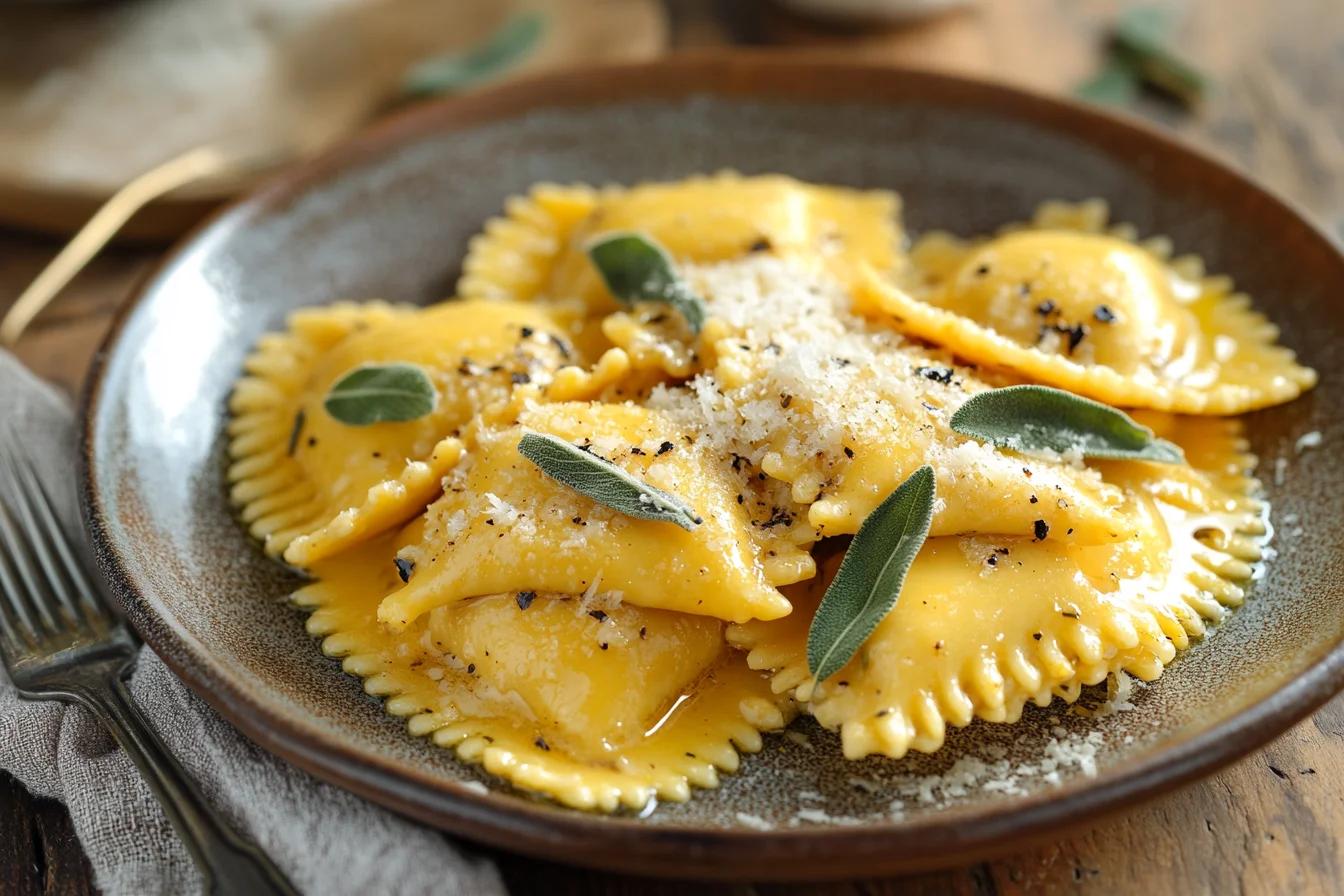
Butternut Squash Ravioli
Ingredients
For the Pasta Dough:
- 2 cups 00 flour or all purpose flour
- 2 large eggs
- 1/2 teaspoon salt
- 1 tablespoon olive oil
- 1-2 tablespoons water if needed
For the Butternut Squash Filling:
- 1 ½ cups roasted butternut squash cubed and mashed
- ½ cup ricotta cheese
- ¼ cup grated Parmesan cheese
- ½ teaspoon nutmeg
- ½ teaspoon salt
- ¼ teaspoon black pepper
For the Brown Butter Sage Sauce:
- 4 tablespoons unsalted butter
- 6-8 fresh sage leaves
- ¼ teaspoon salt
- ¼ teaspoon black pepper
- ¼ cup grated Parmesan for garnish
Instructions
- Step 1: Prepare the Pasta Dough
- On a clean surface, make a mound with the flour and create a well in the center.
- Crack the eggs into the well, add salt and olive oil, and slowly mix with a fork.
- Knead the dough for about 10 minutes until it becomes smooth and elastic.
- Wrap it in plastic wrap and let it rest for at least 30 minutes.
- Step 2: Make the Butternut Squash Filling
- Preheat the oven to 400°F (200°C).
- Toss cubed butternut squash with olive oil and roast for 25 minutes until soft.
- Mash the roasted squash, then mix in ricotta, Parmesan, nutmeg, salt, and pepper. Set aside.
- Step 3: Roll and Fill the Ravioli
- Roll out the pasta dough into thin sheets using a rolling pin or pasta machine.
- Place small spoonfuls of filling onto one pasta sheet, spacing evenly.
- Brush around the filling with water, then cover with another pasta sheet.
- Press around the filling to remove air pockets and seal the ravioli.
- Cut ravioli using a knife or ravioli cutter.
- Step 4: Cook the Ravioli
- Bring a large pot of salted water to a boil.
- Gently add the ravioli and cook for 2-3 minutes until they float to the surface.
- Remove with a slotted spoon and set aside.
- Step 5: Make the Brown Butter Sage Sauce
- In a skillet over medium heat, melt the butter until it turns golden brown.
- Add sage leaves and let them crisp up for about 30 seconds.
- Season with salt and pepper, then toss in the cooked ravioli.
- Step 6: Serve and Enjoy
- Plate the ravioli, drizzle with the brown butter sauce, and garnish with grated Parmesan.
- Serve warm and enjoy.
Notes
- Make Ahead: You can freeze uncooked ravioli in a single layer, then transfer them to an airtight container for up to 3 months.
- Cheese Options: Substitute ricotta with mascarpone for a creamier filling.
- Serving Suggestion: Pairs well with a side of garlic bread or a fresh green salad.
What is Butternut Squash Ravioli?
A Classic Italian Dish with a Seasonal Twist
Ravioli, a beloved stuffed pasta originating from Italy, has been around for centuries. Traditionally filled with cheese, meats, or vegetables, ravioli offers endless variations. One of the most beloved versions, especially in the fall and winter months, is butternut squash ravioli.
The star of this dish is, of course, butternut squash, a naturally sweet and nutty winter squash that pairs beautifully with cheese, herbs, and warm spices. Unlike traditional cheese stuffed ravioli, this version brings a subtle sweetness that complements both creamy and savory sauces.
The Rise in Popularity of Butternut Squash Ravioli
Over the years, butternut squash ravioli has gained immense popularity beyond Italian cuisine. Featured on restaurant menus and available in grocery stores, this dish has become a staple in home kitchens worldwide. Its velvety texture and deep, earthy flavor make it a favorite among pasta lovers, vegetarians, and even those looking for a more gourmet alternative to traditional ravioli.
What makes it stand out? The contrast of flavors. The sweetness of roasted butternut squash is balanced by the slight tanginess of cheese, the richness of butter, and the earthiness of sage, creating a symphony of taste in every bite.
Why Butternut Squash is the Perfect Filling
Not all fillings work well in ravioli, but butternut squash is an exception. Here’s why:
- Creamy texture – When roasted and pureed, butternut squash creates a naturally smooth, velvety filling.
- Mildly sweet flavor – It provides a slightly sweet note that pairs well with both savory and sweet sauces.
- Nutritious powerhouse – Packed with fiber, vitamins A and C, and antioxidants, this squash adds both flavor and health benefits.
- Versatile pairing – Works well with ricotta, Parmesan, mascarpone, and a variety of herbs and spices.
Butternut squash ravioli is more than just a pasta dish, it’s a comforting, restaurant quality meal you can enjoy at home. In the next section, we’ll dive into the essential ingredients you’ll need to make it from scratch.
Key Ingredients for Butternut Squash Ravioli
Essential Components: Pasta Dough and Filling
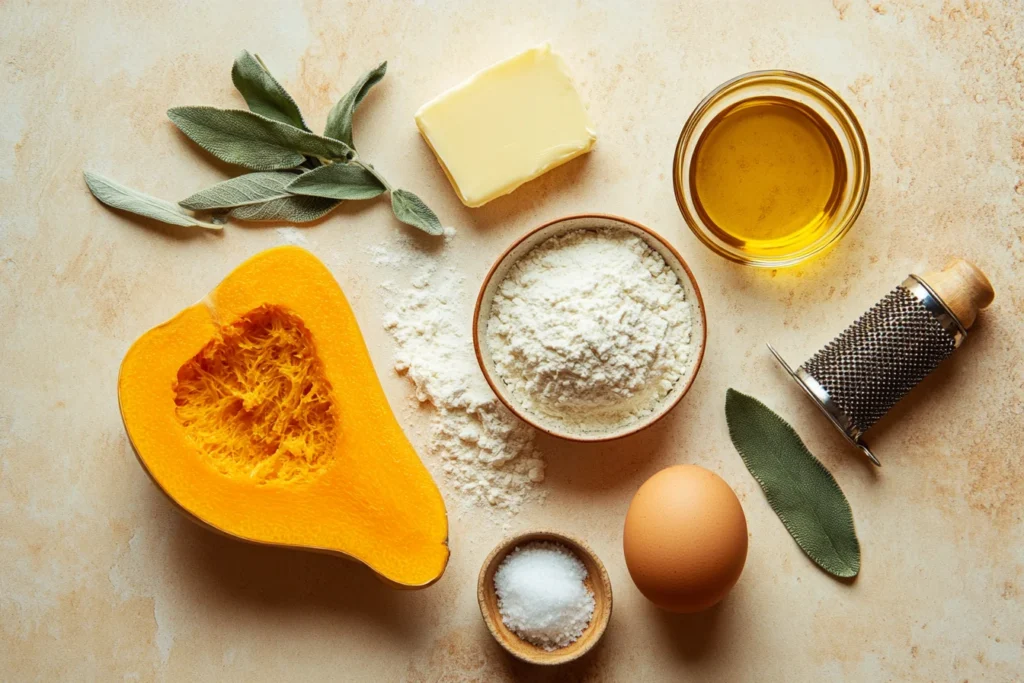
When it comes to making butternut squash ravioli, the magic is in the ingredients. While store bought ravioli is convenient, nothing beats the fresh taste of homemade pasta and filling.
The two core elements are:
- Pasta Dough – The base of any ravioli is a thin, delicate pasta. Traditional pasta dough uses 00 flour, eggs, and a pinch of salt, creating a silky, elastic texture that holds the filling well.
- Filling – The star ingredient, roasted butternut squash, is blended with creamy cheeses like ricotta or mascarpone, Parmesan for depth, and spices like nutmeg for warmth.
Variations: Cheese, Herbs, and Spices to Enhance Flavor
To elevate your butternut squash ravioli, you can experiment with different cheeses and seasonings:
- Ricotta vs. Mascarpone – Ricotta adds a light, slightly grainy texture, while mascarpone makes the filling extra creamy.
- Parmesan or Pecorino – Both cheeses add umami and saltiness.
- Sage and Thyme – Classic herbs that bring out the squash’s earthy sweetness.
- Nutmeg and Cinnamon – A touch of spice enhances the dish’s warm, cozy flavor.
Best Butternut Squash to Use: Fresh vs. Pre Cooked
Should you use fresh or pre cooked butternut squash?
- Fresh squash – Roasting it deepens its natural sweetness and adds a slightly caramelized taste.
- Pre cooked (canned or frozen) – While convenient, it lacks the richness of roasted squash. If using pre cooked, drain excess moisture to avoid a watery filling.
How to Make Homemade Butternut Squash Ravioli
Step by Step Guide to Making Fresh Pasta Dough
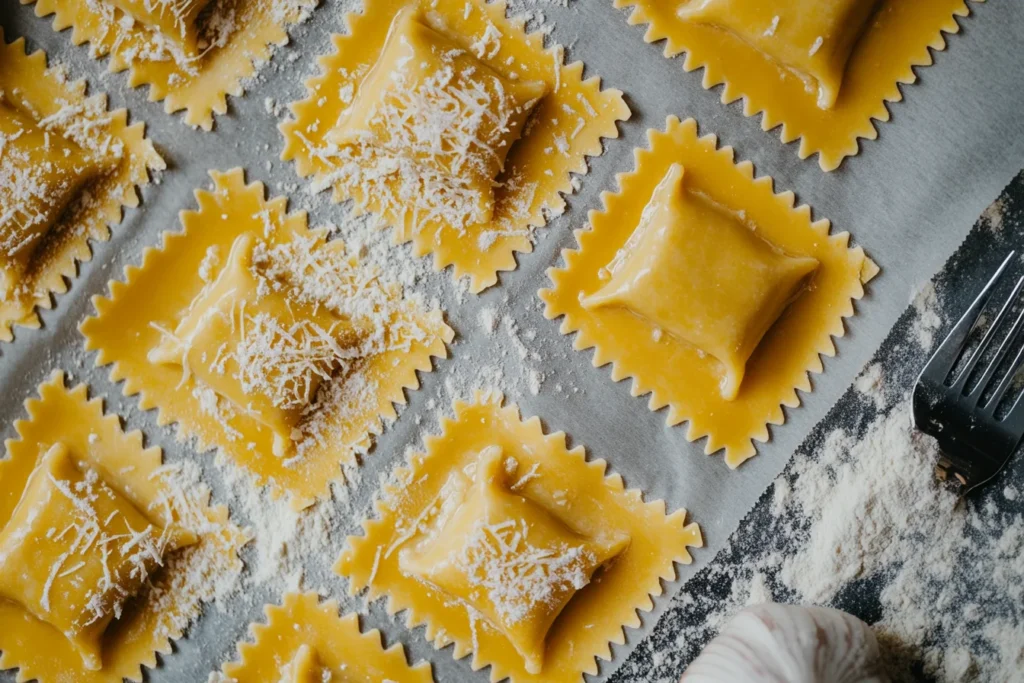
Making fresh ravioli might seem intimidating, but with the right technique, it’s a rewarding process. Here’s how:
- Mix the dough – On a clean surface, form a mound with 00 flour, then create a well in the center. Crack in the eggs and slowly mix with a fork until combined.
- Knead the dough – Work the dough for about 10 minutes until it’s smooth and elastic. Wrap it in plastic and let it rest for at least 30 minutes.
- Roll it out – Using a pasta machine or rolling pin, roll the dough into thin sheets (about 1/16 inch thick).
Preparing the Butternut Squash Filling
The filling should be creamy, flavorful, and well balanced. Here’s how to make it:
- Roast the squash – Cut it into cubes, drizzle with olive oil, and bake at 400°F until tender.
- Blend the filling – Mash or blend the roasted squash with ricotta (or mascarpone), grated Parmesan, salt, pepper, and a pinch of nutmeg.
- Adjust consistency – If the mixture is too wet, add breadcrumbs or Parmesan to thicken it.
Shaping, Filling, and Sealing the Ravioli
Once you have your pasta sheets and filling ready, it’s time to assemble:
- Place filling – Spoon small mounds of filling onto one pasta sheet, spacing them evenly.
- Seal the ravioli – Brush the edges with water or egg wash, then place another sheet on top. Press gently to seal, making sure to remove any air pockets.
- Cut the ravioli – Use a ravioli cutter or knife to trim each piece, then press the edges firmly to prevent leakage during cooking.
Cooking Methods: Boiling vs. Pan Searing
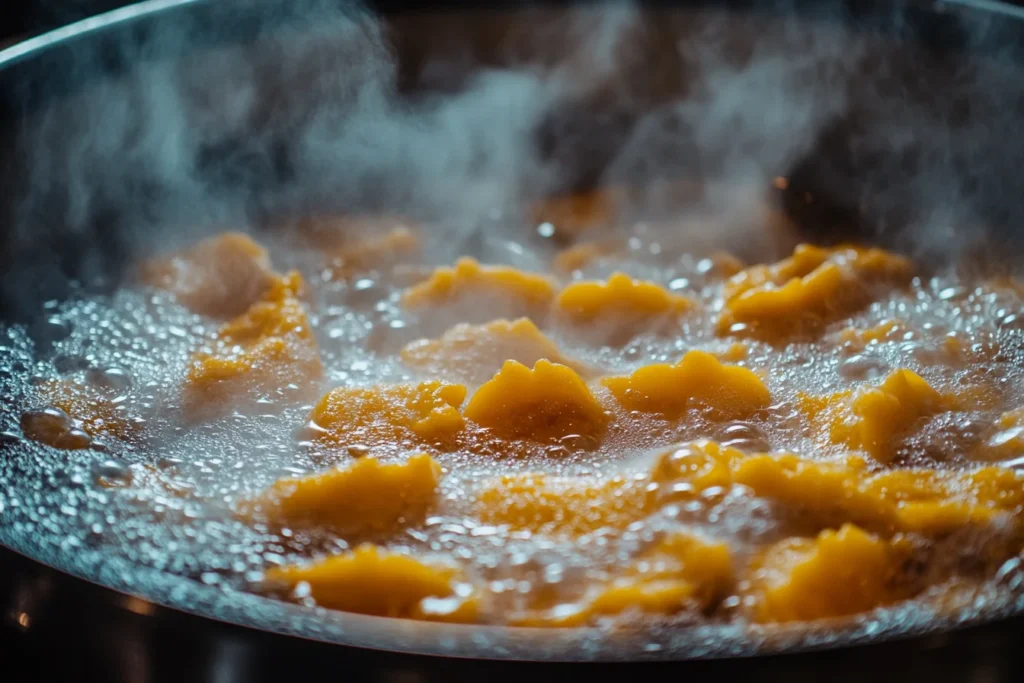
- Boiling (Traditional) – Drop ravioli into salted boiling water. Boil for 2-3 minutes or until they rise to the surface.
- Pan Searing (For Extra Texture) – After boiling, sauté the ravioli in brown butter for a slightly crispy, caramelized exterior.
Now that you know how to make butternut squash ravioli, it’s time to talk about the best sauces to serve it with.
Butternut Squash Ravioli Sauce Pairings
Classic Brown Butter Sage Sauce
One of the most popular ways to serve butternut squash ravioli is with a simple yet flavorful brown butter sage sauce. The nuttiness of the browned butter perfectly complements the sweetness of the squash filling, while the crispy sage adds an aromatic touch.
How to make it:
- Melt unsalted butter in a pan over medium heat until it starts to turn golden brown.
- Add fresh sage leaves and cook until crispy.
- Gently mix the cooked ravioli with the sauce, making sure each piece is evenly coated.
- Finish with a sprinkle of grated Parmesan and freshly ground black pepper.
Alternative Sauces: Creamy Alfredo, Garlic Butter, and Pesto
If you want to switch things up, here are some other delicious sauces that pair well with butternut squash ravioli:
- Creamy Alfredo – A rich, cheesy sauce made with butter, heavy cream, and Parmesan. This adds an indulgent, velvety touch to the ravioli.
- Garlic Butter – Melt butter with minced garlic and a splash of white wine for a light yet flavorful sauce.
- Pesto – A fresh, herby alternative made with basil, pine nuts, garlic, Parmesan, and olive oil. It adds a bright contrast to the sweetness of the squash.
Best Cheese and Toppings to Enhance Flavor
Adding the right toppings can take your butternut squash ravioli to the next level. Here are a few ideas:
- Parmesan or Pecorino – A sharp, salty cheese that balances the dish’s sweetness.
- Toasted walnuts or pine nuts – Adds a nutty crunch.
- A drizzle of balsamic glaze – Enhances the ravioli’s natural sweetness with a tangy contrast.
- Red pepper flakes – For those who like a little heat.
Whether you prefer a classic butter sauce or a creamy Alfredo, the right pairing can make your ravioli even more irresistible.
Store Bought vs. Homemade Butternut Squash Ravioli
Top Rated Store Bought Options
If you’re short on time, store bought butternut squash ravioli is a great alternative to making it from scratch. Many brands offer high quality options with fresh ingredients and authentic flavors. Some of the best choices include:
- Giovanni Rana Butternut Squash Ravioli – A well known brand offering a creamy, flavorful filling with a delicate pasta shell.
- Trader Joe’s Butternut Squash Ravioli – A seasonal favorite with a slightly sweet filling and a hint of nutmeg.
- Whole Foods 365 Butternut Squash Ravioli – Made with organic ingredients for a healthier option.
Pros and Cons of Homemade vs. Packaged Ravioli
Both homemade and store bought ravioli have their advantages and disadvantages:
| Aspect | Homemade | Store Bought |
|---|---|---|
| Flavor | Rich, fresh taste | Good but less fresh |
| Texture | Delicate, silky pasta | Sometimes thicker pasta |
| Convenience | Requires time and effort | Quick and easy |
| Customization | Fully customizable ingredients | Limited options |
Where to Buy the Best Pre Made Ravioli
For those looking to buy high quality butternut squash ravioli, check your local gourmet grocery stores or Italian markets. Many supermarkets like Whole Foods, Trader Joe’s, and even Costco offer excellent options. For a gourmet experience, look for fresh, refrigerated ravioli rather than frozen ones.
Health Benefits and Nutritional Information
Is Butternut Squash Ravioli Healthy?
When made with fresh ingredients, butternut squash ravioli can be a nutritious meal. Butternut squash itself is packed with vitamins, fiber, and antioxidants, making it a great addition to any diet. However, the overall healthiness of the dish depends on the type of pasta, filling ingredients, and sauce choices.
Homemade versions tend to be healthier since you can control the ingredients, avoiding preservatives and excessive sodium found in some store bought ravioli. Pairing it with a light sauce, such as brown butter or olive oil with fresh herbs, keeps the dish balanced and flavorful without being too heavy.
Nutritional Content (Per 100g Serving)
The nutritional value of butternut squash ravioli can vary depending on ingredients, but here’s an approximate breakdown for a homemade version with a traditional filling:
| Nutrient | Amount per 100g |
|---|---|
| Calories | 210 kcal |
| Carbohydrates | 32g |
| Protein | 7g |
| Fats | 6g |
| Saturated Fat | 2.5g |
| Fiber | 2.5g |
| Sodium | 180mg |
| Vitamin A | 3500 IU |
| Vitamin C | 6mg |
| Calcium | 80mg |
| Iron | 1.2mg |
Butternut squash is an excellent source of vitamin A, supporting eye health, while fiber helps with digestion. To make this dish even healthier, consider using whole wheat pasta, reducing cheese content, or adding leafy greens as a side.
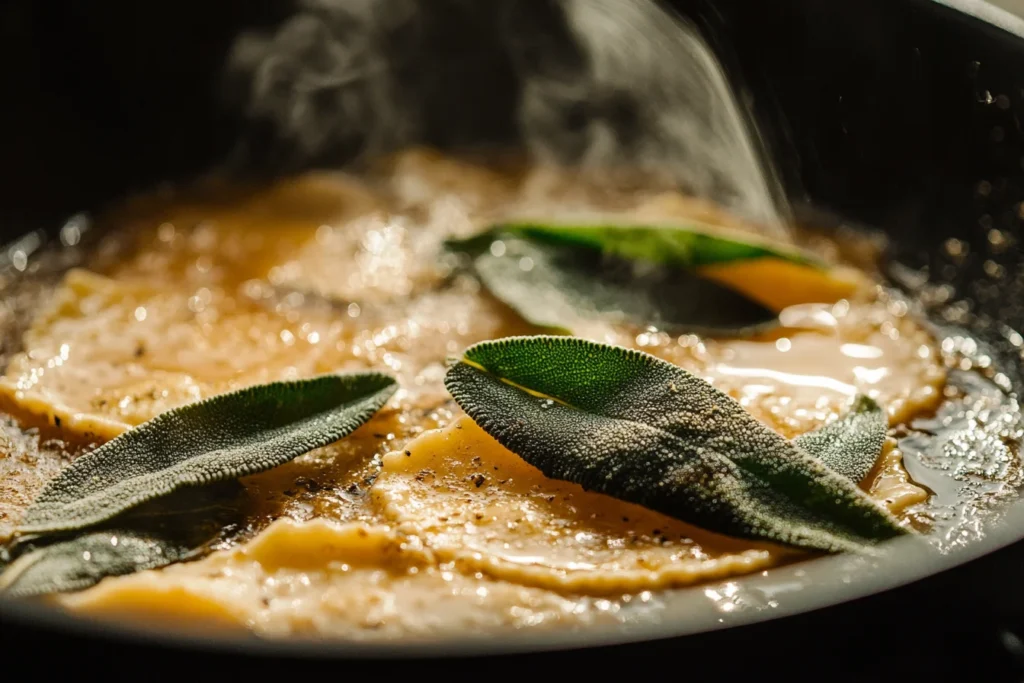
FAQs on Butternut Squash Ravioli
What is the best sauce for butternut squash ravioli?
The most popular sauce for butternut squash ravioli is brown butter with crispy sage. Its nutty richness enhances the squash’s natural sweetness. Other great options include:
- Garlic butter sauce – Simple and flavorful, made with butter, garlic, and a hint of lemon.
- Parmesan cream sauce – A rich, cheesy sauce that pairs beautifully with the ravioli’s smooth texture.
- Pesto sauce – Adds a fresh, herby contrast to the sweetness of the filling.
Can you freeze homemade butternut squash ravioli?
Yes! To freeze homemade ravioli, arrange the pieces in a single layer on a baking sheet and freeze for an hour. Once solid, transfer them to an airtight bag or container. When ready to cook, boil them directly from frozen, no need to thaw.
How do you prevent ravioli from bursting while cooking?
To avoid bursting, be sure to:
- Seal the edges properly by pressing out any air pockets.
- Boil gently, use a slow simmer instead of a rolling boil.
- Avoid overcrowding the pot, which can cause the ravioli to bump into each other and break.
What wine pairs well with butternut squash ravioli?
Since butternut squash ravioli has a naturally sweet, earthy flavor, it pairs well with:
- Chardonnay – A creamy, buttery white wine that complements the richness of the dish.
- Sauvignon Blanc – A crisp, citrusy wine that balances the sweetness of the squash.
- Pinot Noir – A light red with earthy undertones that enhances the ravioli’s nutty flavors.
If you’re a fan of butternut squash ravioli, you might also enjoy trying other stuffed pasta dishes. For a seafood twist, check out this lobster ravioli recipe, featuring a rich and creamy filling. If you love classic flavors, this cheese ravioli is a must try, offering a simple yet delicious homemade option.
Looking for the perfect side dish? Browse through these pasta side dishes to find the best pairings for your ravioli. Whether you prefer a light salad or a cheesy garlic bread, these sides will elevate your meal. 🍽️😊
Conclusion
Butternut squash ravioli is a dish that brings together rich flavors, creamy textures, and comforting warmth. Whether you make it from scratch or opt for a high quality store bought version, this pasta dish is perfect for cozy fall nights or elegant dinner parties.
We’ve covered everything you need to know, from key ingredients and homemade preparation to the best sauces and wine pairings. Plus, we’ve explored its health benefits and answered common questions to help you make the most of this delicious meal.
Now, it’s your turn to try making butternut squash ravioli. Experiment with different fillings, sauces, and toppings to create a version that suits your taste. And if you’re looking for more pasta inspiration, don’t forget to check out other comforting recipes to expand your homemade Italian dishes.
Enjoy your homemade butternut squash ravioli, and happy cooking. 🍽️😊